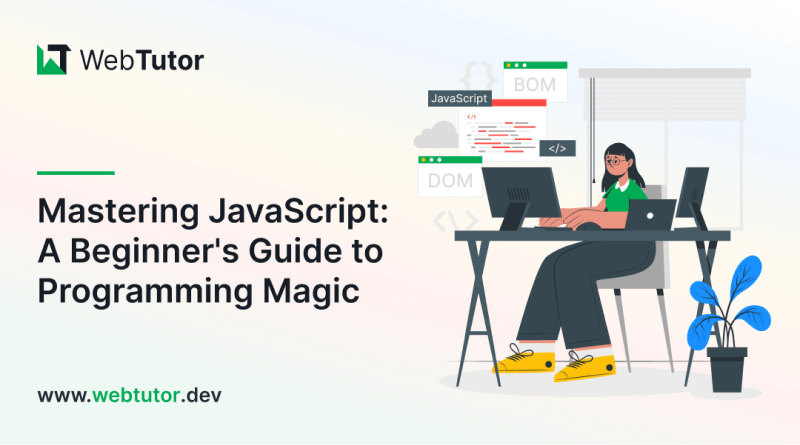JavaScript is a versatile and powerful programming language that is used by developers across the world. It is one of the most popular programming languages due to its ability to create everything from simple web pages to complex web applications.
With JavaScript, you can build interactive websites, create mobile apps, and even build games.
However, if you are new to programming, JavaScript can seem daunting. With so many functions, tools, and libraries, where do you even start?
That's where this beginner's guide comes in. In this guide, we'll take you through the fundamentals of JavaScript, including its history, syntax, and most useful functions and tools.
Whether you're interested in building a website, creating a mobile app, or simply want to understand how programming works, this guide will help you get started on the path to mastering JavaScript.
Why Learn JavaScript?
JavaScript is a versatile and popular programming language that is used to create everything from simple web pages to complex web applications. It is the only language that runs natively in the browser, meaning that it can be used to create dynamic and interactive websites.
JavaScript is also used on the server-side with popular frameworks like Node.js, which allows developers to build scalable and real-time applications. By learning JavaScript, you will have access to a wide range of job opportunities, as it is one of the most in-demand skills in the industry.
Another reason to learn JavaScript is that it is relatively easy to learn compared to other programming languages. It has a simple syntax, making it a great language for beginners to start with.
JavaScript is also supported by a large and active community of developers who create libraries, frameworks, and tools to make development easier. With the right resources and practice, you can quickly become proficient in JavaScript.
Finally, learning JavaScript can be a fun and rewarding experience. JavaScript is used to build some of the most popular websites and applications in the world, including Facebook, Google, and Amazon. By learning JavaScript, you can start building your own projects and contribute to the open-source community.
JavaScript Fundamentals: Variables, Data Types, and Operators
Before you start building applications with JavaScript, it's important to understand the fundamental concepts of the language. In this section, we'll cover variables, data types, and operators.
- Variables in JavaScript are used to store data. They are declared using the
var,let, orconstkeyword, followed by the variable name. The var keyword is used to declare a variable that can be reassigned, while let is used to declare a variable that can be reassigned but is limited to the block scope. The const keyword is used to declare a variable that cannot be reassigned. - Data types in JavaScript include
strings,numbers,booleans,null, andundefined. Strings are used to represent text and are enclosed in either single or double quotes. Numbers are used to represent numerical values, including integers and floating-point numbers. Booleans are used to represent true or false values. Null represents a deliberate non-value, while undefined is used to represent the absence of a value. - Operators in JavaScript are used to perform operations on data. They include arithmetic operators like
+, -, *, and /,as well as comparison operators like==, !=, <, >, <=, and >=. Logical operators like&&, ||, and !are used to perform logical operations on data.
Control Flow Statements: If/Else, Switch Statements, and Loops
Control flow statements in JavaScript are used to control the flow of execution in a program. They include if/else statements, switch statements, and loops.
If/else statements are used to execute code based on a condition. If the condition is true, the code in the if block is executed. If the condition is false, the code in the else block is executed. Switch statements are used when there are multiple conditions to check. They evaluate an expression and execute code based on the result.
Loops in JavaScript are used to execute code repeatedly. There are two types of loops in JavaScript: for loops and while loops. For loops are used to execute code a fixed number of times, while while loops are used to execute code as long as a condition is true.
Functions in JavaScript
Functions in JavaScript are used to encapsulate code and make it reusable. They are declared using the function keyword, followed by the function name, and a set of parentheses that contain the function's parameters.
The code inside the function is enclosed in curly braces. Functions can take arguments, which are passed in when the function is called. They can also return a value using the return keyword.
Functions can be declared as function expressions or function declarations. Function expressions are anonymous functions that are assigned to a variable, while function declarations are named functions that are defined using the function keyword.
Arrays and Objects in JavaScript
Arrays and objects are two important data structures in JavaScript. Arrays are used to store lists of data, while objects are used to store key-value pairs.
Arrays in JavaScript are created using square brackets []. They can contain any type of data, including numbers, strings, and other arrays. You can access the elements of an array using their index, which starts at 0.
Objects in JavaScript are created using curly braces {}. They can contain any number of key-value pairs, where the key is a string and the value can be any data type. You can access the values of an object using the dot notation or bracket notation.
DOM Manipulation with JavaScript
The Document Object Model (DOM) is a programming interface for web documents. It represents the page so that programs can change the document structure, style, and content. DOM manipulation with JavaScript is used to dynamically change the content of a web page.
To manipulate the DOM with JavaScript, you first need to select an element using one of the selection javascript methods like getElementById, getElementsByClassName, or querySelector. Once you have selected an element, you can change its properties like its text content, HTML content, or CSS styles.
Event listeners in JavaScript are used to respond to user actions like clicks, mouse movements, or keyboard inputs. They are attached to elements using the addEventListener method. When an event occurs, the specified function is executed.
Best Resources for Learning JavaScript
There are many resources available for learning JavaScript, including books, online courses, and tutorials. Here are some of the best resources for learning JavaScript:
- WebTutor offers a complete list of free online tutorials on all the major front end technologies.
- Codecademy offers a comprehensive JavaScript course that covers all the basics of the language.
- MDN Web Docs is a great resource for learning JavaScript. It has a comprehensive guide to the language, as well as tutorials and examples.
- Eloquent JavaScript is a popular book that covers all the basics of the language. It is available for free online.
- JavaScript.info is a comprehensive resource for learning JavaScript. It covers all the basics of the language, as well as advanced topics like asynchronous programming.
Common Mistakes to Avoid While Learning JavaScript
Learning JavaScript can be challenging, but it's important to avoid some common mistakes that beginners make. Here are some of the most common mistakes to avoid while learning JavaScript:
1. Not Understanding the Fundamentals
It's important to understand the fundamentals of JavaScript, including variables, data types, and operators, before moving on to more advanced topics.
2. Not Practicing Enough
Learning JavaScript takes practice. Make sure to practice regularly and build projects to reinforce what you've learned.
3. Not Using the Right Resources
There are many resources available for learning JavaScript, but not all of them are created equal. Make sure to use reputable resources like books, online courses, and tutorials.
4. Not Asking for Help
If you get stuck, don't be afraid to ask for help. There are many online communities and forums where you can get help from other developers.
Conclusion
JavaScript is a powerful and versatile programming language that is used by developers across the world. With JavaScript, you can build everything from simple web pages to complex web applications. By learning JavaScript, you will have access to a wide range of job opportunities, as it is one of the most in-demand skills in the industry.
With the right resources and practice, you can quickly become proficient in JavaScript and start building your own projects. So if you're ready to unlock the magic of programming, start learning JavaScript today.

